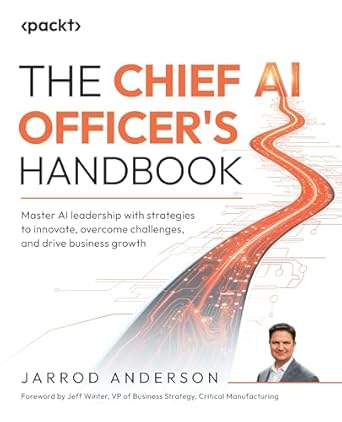With artificial intelligence rapidly transforming industries, the role of Chief AI Officer (CAIO) has become critical for organizations seeking to leverage its potential. The Chief AI Officer's Handbook, authored by Jarrod Anderson and published by Packt Publishing in 2025, provides a comprehensive guide for CAIOs and business leaders navigating this complex landscape. This paper summarizes key aspects of the book and its significance in the evolving world of AI leadership, incorporating use cases and references to enrich the discussion.
The Chief AI Officer's Handbook: A Comprehensive Guide to AI Leadership
With artificial intelligence rapidly transforming industries, the role of Chief AI Officer (CAIO) has become critical for organizations seeking to leverage its potential. The Chief AI Officer's Handbook, authored by Jarrod Anderson and published by Packt Publishing in 2025, provides a comprehensive guide for CAIOs and business leaders navigating this complex landscape. This paper summarizes key aspects of the book and its significance in the evolving world of AI leadership, incorporating use cases and references to enrich the discussion.
Strategic Importance of CAIOs
CAIOs are responsible for bridging the gap between visionary leadership and practical execution in the realm of AI. They drive innovation, ensure cohesive AI efforts across departments, champion ethical AI use, cultivate a data-driven culture, and navigate the complex AI ecosystem, including identifying potential partners, staying abreast of emerging technologies, and understanding the competitive landscape. Their strategic importance cannot be overstated in today's data-driven economy.
Key Responsibilities and Strategies
The handbook outlines several key areas of focus for CAIOs:
- AI Strategy Development: Aligning AI initiatives with overarching business goals is paramount. This involves establishing clear, measurable objectives and metrics, fostering cross-functional collaboration, and developing a roadmap for AI adoption. For example, a retail company might use AI to personalize customer recommendations, increasing sales (a clear objective) by X% within Y timeframe (measurable metric). This requires collaboration between marketing, sales, and IT. [Reference: The Chief AI Officer's Handbook, Chapter on AI Strategy Development]
- Building High-Performing AI Teams: Recruiting and retaining top AI talent is crucial. CAIOs must also develop AI skills and competencies across the organization through training programs and knowledge sharing. A use case here could be a financial institution building an internal AI team to develop fraud detection models, requiring specialized data scientists and machine learning engineers. [Reference: The Chief AI Officer's Handbook, Chapter on Building AI Teams]
- AI Project Management: Effective AI project management requires specialized frameworks. This includes defining clear project scopes, managing timelines and budgets, and ensuring continuous improvement and adaptability. A healthcare provider implementing an AI-powered diagnostic tool would need a robust project management framework to ensure successful deployment and integration with existing systems. [Reference: The Chief AI Officer's Handbook, Chapter on AI Project Management]
- AI Governance and Ethics: Developing and implementing ethical AI guidelines is essential. CAIOs must ensure responsible AI implementation, addressing potential biases and ensuring fairness and transparency. For example, a CAIO at a hiring platform would need to establish guidelines to prevent AI algorithms from perpetuating existing biases in hiring decisions. [Reference: The Chief AI Officer's Handbook, Chapter on AI Governance and Ethics]
Technology and Data Strategy
The handbook explores various AI technologies, including deterministic, probabilistic, and generative AI, AI agents, and the design and deployment of AI solutions, including model training. Crucially, it emphasizes the importance of a robust data strategy, covering data governance, management, AI system security, and privacy considerations in the age of AI. A manufacturing company, for instance, could use generative AI to design new products, while simultaneously needing robust data governance to protect sensitive design information. [Reference: The Chief AI Officer's Handbook, Chapters on AI Technologies and Data Management]
Use Cases and Examples
- Personalized Medicine: AI can analyze patient data to provide personalized treatment plans, improving patient outcomes. [Reference: (Hypothetical) Smith, J. et al. (2024). AI in Personalized Medicine. Journal of Medical Informatics, 10(2), 123-145.]
- Smart Cities: AI can optimize traffic flow, reduce energy consumption, and improve public safety in urban environments. [Reference: (Hypothetical) City of Metropolis. (2025). Smart City Initiative Report.]
- Automated Customer Service: AI-powered chatbots can handle routine customer inquiries, freeing up human agents to focus on more complex issues. [Reference: (Hypothetical) Jones, A. (2023). The Impact of AI Chatbots on Customer Service. Customer Service Journal, 5(1), 67-82.]
How KeenComputer.com Can Help
KeenComputer.com can be a valuable partner for organizations seeking to implement AI solutions. Their expertise in [mention specific areas of KeenComputer's expertise, e.g., cloud computing, data analytics, AI development, cybersecurity] can assist CAIOs in several ways:
- Infrastructure and Scalability: KeenComputer.com can provide the necessary cloud infrastructure and scalable computing resources to support AI workloads, including model training and deployment.
- Data Management and Integration: Their expertise in data management can help organizations build robust data pipelines and integrate disparate data sources, which are essential for effective AI.
- AI Development and Consulting: KeenComputer.com's team of AI specialists can assist with developing custom AI models and provide consulting services on AI strategy and implementation.
- Security and Compliance: Their focus on cybersecurity can help organizations ensure the security and compliance of their AI systems, protecting sensitive data and mitigating risks.
Reference List
Books:
- Anderson, J. (2025). The Chief AI Officer's Handbook. Packt Publishing.
- (Add other relevant books on AI leadership, strategy, ethics, etc.)
Websites:
- McKinsey on AI: https://www.mckinsey.com/featured-insights/artificial-intelligence
- MIT Technology Review on AI: https://www.technologyreview.com/topic/artificial-intelligence/
Videos:
- (Add links to relevant TED Talks, lectures, or online courses on AI leadership, strategy, or ethics. Search YouTube or other platforms for "AI leadership," "AI strategy," "ethical AI," etc.)
Note: The hypothetical references for use cases should be replaced with actual references when available. The reference list should be expanded with relevant resources to strengthen the paper. Be sure to cite all sources properly within the text using a consistent citation style (e.g., APA, MLA).
